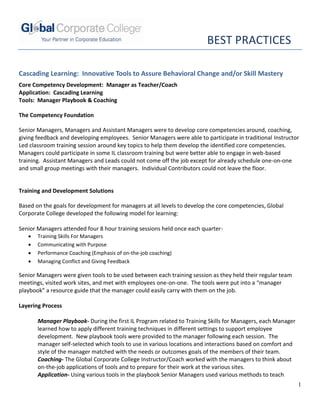CascadeLearning_InnovativeToolstoAssureBehavioralChangeand_orSkillMastery
- 1. BEST PRACTICES 1 Cascading Learning: Innovative Tools to Assure Behavioral Change and/or Skill Mastery Core Competency Development: Manager as Teacher/Coach Application: Cascading Learning Tools: Manager Playbook & Coaching The Competency Foundation Senior Managers, Managers and Assistant Managers were to develop core competencies around, coaching, giving feedback and developing employees. Senior Managers were able to participate in traditional Instructor Led classroom training session around key topics to help them develop the identified core competencies. Managers could participate in some IL classroom training but were better able to engage in web-based training. Assistant Managers and Leads could not come off the job except for already schedule one-on-one and small group meetings with their managers. Individual Contributors could not leave the floor. Training and Development Solutions Based on the goals for development for managers at all levels to develop the core competencies, Global Corporate College developed the following model for learning: Senior Managers attended four 8 hour training sessions held once each quarter-  Training Skills For Managers  Communicating with Purpose  Performance Coaching (Emphasis of on-the-job coaching)  Managing Conflict and Giving Feedback Senior Managers were given tools to be used between each training session as they held their regular team meetings, visited work sites, and met with employees one-on-one. The tools were put into a “manager playbook” a resource guide that the manager could easily carry with them on the job. Layering Process Manager Playbook- During the first IL Program related to Training Skills for Managers, each Manager learned how to apply different training techniques in different settings to support employee development. New playbook tools were provided to the manager following each session. The manager self-selected which tools to use in various locations and interactions based on comfort and style of the manager matched with the needs or outcomes goals of the members of their team. Coaching- The Global Corporate College Instructor/Coach worked with the managers to think about on-the-job applications of tools and to prepare for their work at the various sites. Application- Using various tools in the playbook Senior Managers used various methods to teach
- 2. BEST PRACTICES 2 around the core competencies of communication, coaching, managing conflict and giving feedback. A Sample of tools used included: o Small group role plays o One-on-one learning bites o 45 Minute Team Learning moment sessions o On-the-job check list “Looking for what is working” o Story Telling for Learning o Coaching Guides Small Group Coaching- Senior Managers met virtually with their Global Corporate College Instructor/Coach and other Senior Managers to talk about how the model was working, how to overcome barriers, and to share best practices. The model was modified so that Managers using Web/Based Learning and ELearning to replace IL classroom learning, could learn to use the same concepts and a modified Managers Playbook was provided so that they could teach the same principles at an appropriate application level for their Assistant Managers and Leads. Coaching was provided to the Managers by their Senior Manager. Assistant Managers and Leads followed a similar but modified model to apply the learning and to teach the concepts in their daily work with individual contributors. Coaching was provided by their Manager. Analysis Phase This model allowed all participants to learn the core skills required to develop the competencies that had been identified. The Cascade Model allowed each leader to push the learning down into the organization thus increasing the impact of the initial IL courses. As a part of the process, each level of management demonstrated and practiced the core goal of developing “their people”, a company-wide priority. They received both individual and group coaching which modeled the behavior they were to provide to their next level of reports. They developed cross location relationships and shared best practices opening up communication and collaboration among leaders of the locations and diminishing the level of existing competition which led to better overall company performance. Employees expressed through various feedback tools and increased feeling of being cared about by management and thus were more engaged in their work and in the company. Enhancement of Existing Global Corporate College Curriculum  Using the competency behaviors as the focal point, Global Corporate College reviewed the existing curriculum content and revised content to ensure the learning objectives were aligned with the behaviors identified.
- 3. BEST PRACTICES 3 ď‚· Generic examples or case studies were replaced with organizational and site specific content developed by Global Corporate College. ď‚· Pre and post session tools were added to course content to reinforce learning and application back on the job. New Solutions ď‚· Manager Playbooks were developed for each level of management. ď‚· Individual and Group Coaching Guides were developed.



